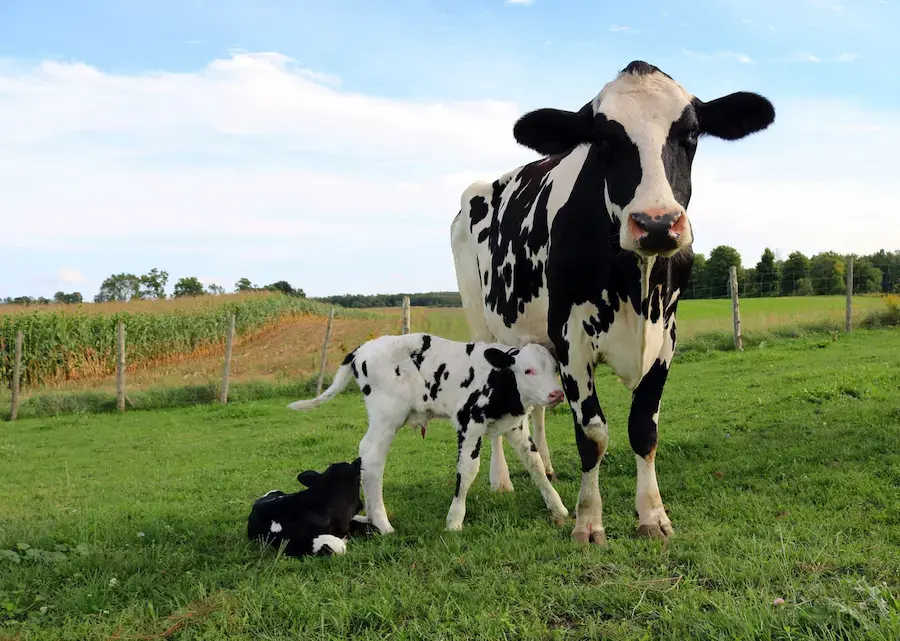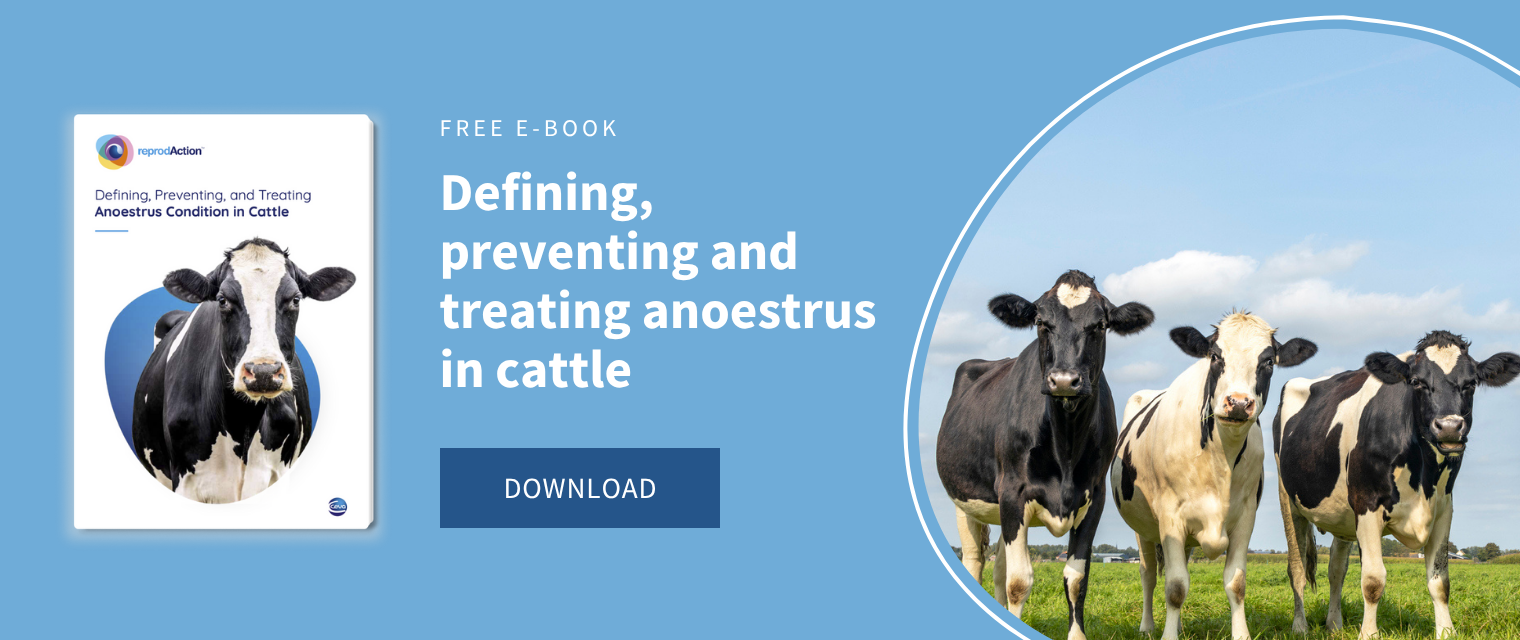When talking about profitability of a dairy farm, the first thing we think of is the amount of milk produced: the more milk per cow, the more profitable the farm. However, production is of little use if the cows are not able to reproduce adequately1. What do we consider adequate? Initially, in cattle, reproductive efficiency was considered adequate when one calving per cow per year was achieved. Nevertheless, as production increased faster and faster, mainly due to the intensity of breeding programs and improvements in feeding, it was proposed that this interval should be lengthened to give cows more time to recover after calving, and also to avoid drying high producing cows. In turn, since the lactation curve in cows with 2 or more calvings does not remain constant throughout lactation, by extending its duration the production decreases and so does the economic profitability of the farm1 (Figure 1).
Prefer to listen to this article? Click the play button below and enjoy our podcast!
Figure 1. Graphical representation of the difference between having an average days in milk (DIM) of 180 and 210. More than 3 kg of milk per cow per day are lost. On this farm with 60 cows in milk, it represents an annual loss of 65700 kg of milk. Despite having high producing cows, they are becoming pregnant later due to reproductive problems or management decisions, i.e. they are not efficient from a reproductive point of view.
Finally, we should not forget another important factor for the profitability of dairy farms: the longevity of the cows. As a general rule, a cow starts to show a profit after the peak of her second lactation2. If she is culled before her third calving, she will provide little profit or even losses. This is why longevity is included in genetic selection programs and why it is important to maintain appropriate conditions on the farm so that animals remain healthy as long as possible.
Most relevant factors in reproductive efficiency
As it has been stated above, it is clear that reproductive efficiency is as important as individual cow production if high profitability is the ultimate goal. Accordingly, the most important factors to accomplish proper reproductive efficiency are:
- The voluntary waiting period (VWP): the VWP is the time after calving that we voluntarily decide to wait on a farm before starting inseminating cows. This period is necessary to allow for the recovery of reproductive capacity, which includes uterine involution and the resumption of ovarian cyclicity. The minimum VWP should be 60 days when relying on oestrus detection for 1st AI; however, in dairy cows and under current production conditions particularly when using fertility programs for first AI 65 to 80 days WVP is the most valid option. One of the most important factors influencing the recovery of reproductive capacity in the postpartum period is the severity and the duration of the Negative Energy Balance (NEB), which depends mainly on body condition at calving, postpartum pathologies, milk production and feeding. If these factors are controlled, the appropriate VWP would be the one indicated above (60-70 days postpartum).

- Conception rate (CR%): can be defined as the ability of a cow to become pregnant after artificial insemination. Once the VWP has passed, the cow should be inseminated at the first heat detected, or in the case of the use of fertility programs like “Double-Ovsynch” at the end of the protocols. Thereafter, the interval between calving and gestation will be determined by her conception rate; if the interval is prolonged, so will be the calving interval and, as a consequence, the mean DIM of the farm. In dairy farms, conception rates for all the services and all the lactations above 35% can be considered adequate.
- Heat detection rate (HDR%): it defines the percentage of eligible cows that is successfully inseminated every 21 days, it takes into account all the animals inseminated regardless of the method for submission; and very straightforward, if a cow will not be inseminated, will not become pregnant. To achieve good reproductive efficiency, HDR should be kept above 60%.
- Pregnancy rate (PR%): it is the parameter that combines the two previous ones, which makes it a very good indicator of the evolution of the reproductive efficiency on a farm1. This parameter is determined every 21 days (length of an oestrus cycle) since the end of the VWP, calculating the percentage of cows that become pregnant out of those available in each 21 days period. PR below 20% should be considered deficient, and PR above 25% can be considered adequate.

Figure 2.- Simulation of the variation of pregnancy rate according to heat detection rate and fertility
How to increase pregnancy rate
As explained in the previous section, and as shown in Figure 2, there are two ways to improve PR:
- Increasing fertility: on farms with CR below 30%, it may be easier, as there is certainly some cause that can be solved. However, when CR exceeds 35%, it becomes difficult.
- Increasing heat detection rate: in principle, this is the easiest way to increase PR, as there are multiple strategies that can be used in this regard, the systematic application of fertility programs like Double-Ovsynch for first AI and Ovsynch and Progesterone based-Synchronisation programs for cows detected open at pregnancy diagnosis. Results in a significant increase of submission for insemination, combining this strategy with activity monitors can increase the speed at which cows become pregnant1,3,4.
Conclusion
Reproductive efficiency is essential to ensure adequate profitability in dairy cattle farms. To achieve this, the first step is to establish an adequate voluntary waiting period, based on farm’s characteristics. The second thing is to establish a monitoring system that allows us to detect problems quickly. In this respect, the pregnancy rate is a good indicator of reproductive status, judging the HDR% and the CR% which generates this parameter, we can easily identify the reproductive bottlenecks which can limit the farms’ performances.
References
- Cardoso Consentini, C. E., Wiltbank, M. C., & Sartori, R. (2021). Factors that optimize reproductive efficiency in dairy herds with an emphasis on timed artificial insemination programs. Animals, 11(2), 301.
- Boulton, A. C., Rushton, J., & Wathes, D. C. (2017). An empirical analysis of the cost of rearing dairy heifers from birth to first calving and the time taken to repay these costs. Animal : an international journal of animal bioscience, 11(8), 1372–1380.
- Santos, C. A. D., Landim, N. M. D., Araújo, H. X. D., & Paim, T. D. P. (2022). Automated systems for estrous and calving detection in dairy cattle. AgriEngineering, 4(2), 475-482.
- Colazo, M. G., & Mapletoft, R. J. (2014). A review of current timed-AI (TAI) programs for beef and dairy cattle. The Canadian Veterinary Journal, 55(8), 772.
About the author
Federico Randi (Ruminants Global Technical Manager)
Federico Randi is Global Technical Manager for Ruminants at Ceva Animal Health, specializing in cattle reproduction. With a Doctor of Veterinary Medicine degree “cum laude” from the University of Bologna, he focused his career on improving efficiency and sustainability of farmed animals. Randi conducts research on ruminants fertility, using technologies like Timed AI, embryo transfer, and recombinant technologies. His extensive experience includes collaborative projects with over 20 research institutions globally. He earned his PhD at University College Dublin, concentrating on fixed-time artificial insemination and embryonic maternal communication in cattle. Currently, he serves as a Board Member in the Scientific Commission of Animal Physiology for the European Federation of Animal Science (EAAP) as an Industry Representative.
About the author
Uxía Yáñez (Predoctoral Fellow)
About the author
Dr. Luis A. Quintela (Senior Lecturer in Animal Reproduction)



Leave your comments here